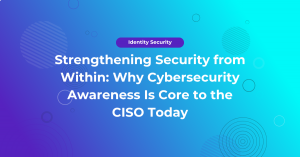IT security resilience of an organization highly depends on how effectively privileged users work with its IT infrastructure. As the saying goes — with great power comes great responsibility. The question is — do you rely on the privileged users to be in control of your IT infrastructure security and stability, or do you take matters into your own hands by enforcing the Principle of Least Privilege?
Forrester Research estimates at least 80% of security breaches involve privileged credentials. Such incidents as those which happened in Cisco, Uber, Microsoft etc., all of them are connected with privileged accounts.
Least privilege is one of the well known information security practices that tells us that a user should only have the minimum necessary set of rights required to complete a job successfully and those rights should be in effect for the shortest duration necessary.
Giving them more permissions and higher access level can allow that user to access information or affect critical IT components in unwanted ways and be a potential source of danger.
When we say privileged access it naturally means that it allows users to bypass certain security measures. In that case, careful assignment of access rights can prevent attackers from damaging corporate information systems.
It is very important to watch over what IT resources each privileged user can access and what rights they have. Whenever employees are promoted or moved to another position it is vital to make sure that the privileges they previously had have been revoked before providing them a set of new privileges.
Otherwise the company may face the privilege creep which means that some users have accumulated unnecessary permissions. There may appear privileged users who are called super administrators . Such a situation often leads to significant security threats.
How is the Principle of Least Privilege (PoLP) important to your organization?
The Principle of Least Privilege (PoLP) is a key element of the Zero Trust concept, which assumes that no user or system should be trusted by default. Every action must be verified and controlled continuously. Full-time and direct access to privileged accounts creates unnecessary risks — those privileges should always be limited.
Why excessive privileges are dangerous
Administrators should not have constant knowledge of passwords or own SSH keys. Instead, they should access them through dedicated security services without disclosure. The more privileges users possess, the harder it becomes to monitor and protect them. That’s why privilege limitation is essential for maintaining full control over critical systems.
Reducing the risk of credential-based attacks
With a growing number of attacks exploiting privileged credentials, controlling user privileges has become a top priority. By implementing PoLP, employees gain access only to the specific IT resources they need — and only for a limited period. This reduces the attack surface and minimizes the potential damage of compromised credentials.
Stopping privilege escalation
Attackers often use social engineering techniques to gain initial access and then escalate privileges. Enforcing PoLP prevents this by ensuring that unnecessary permissions simply don’t exist, stopping escalation attempts before they begin.
Maintaining efficiency with just-in-time access
Restricting privileged access doesn’t have to reduce productivity. When combined with just-in-time privilege elevation, users can obtain the rights they need to perform specific tasks — only when necessary. This ensures operational efficiency while keeping privileged accounts secure.
Compliance and regulations
Many industry regulations require the enforcement of the Principle of Least Privilege and Zero Trust for privileged accounts. Implementing these measures not only enhances security but also helps organizations comply with legal and data protection standards.
How to implement Least Privilege?
Start with a complete privilege audit
The first step toward implementing the Principle of Least Privilege (PoLP) is visibility. Conduct a detailed audit to identify all known and unknown privileged accounts across your IT environment. This helps uncover shadow admin accounts and other high-risk credentials that might have been overlooked.
Revoke unnecessary rights
Once you have a full picture, remove excessive privileges. Every user should have only the access necessary to perform their daily tasks — nothing more. This minimizes potential misuse and limits the attack surface.
Redefine job roles
Review and update job descriptions to ensure there are no “super administrators.” No single person should have rights to manage both critical systems like Active Directory and security solutions simultaneously. Segregating duties strengthens accountability and reduces insider risk.
Create an access matrix
Develop an Access Matrix that clearly maps out permissions for all privileged users and information security officers. This helps balance rights across roles and ensures consistency in how access is granted.
Take privileged users under control
All privileged accounts must be monitored and controlled. A dedicated Privileged Access Management solution makes this process efficient by centralizing session control, logging, and access oversight.
Discover undocumented accounts
Unmanaged or undocumented privileged accounts pose major security risks. Use Account Discovery features within your PAM solution to detect and manage them automatically — minimizing manual effort and closing hidden security gaps.
Enforce password rotation and automation
Regular password rotation prevents credential reuse and unauthorized access. Use automatic password change tools to generate random, policy-compliant passwords after each use. Automated scheduling eliminates human error and prevents bypassing of PAM controls.
Monitor sessions in real time
Continuous visibility is key. Session monitoring and recording allow you to track privileged user activity, including connection details, executed commands, file transfers, and applications launched. This data is essential for auditing and forensic analysis.
Strengthen authentication
Protect privileged access with multi-factor authentication and strict identity verification. This reduces the risk of credential theft and prevents insiders from denying responsibility for their actions.
Establish access policies and just-in-time access
Finally, configure access policies to define rules for connection time, approval workflows, and duration limits. Enable just-in-time access so users can connect to privileged accounts only when needed — and only for as long as required.
Implementing a reliable and cost-effective Privileged Access Management solution that offers a wide range of functions to control privileged access will allow you to comply with Principle of Least Privilege which will help to build your path towards resilient IT security of your organization. Axidian Privilege can help you to start this journey, download a presentation to learn more about the solution.



